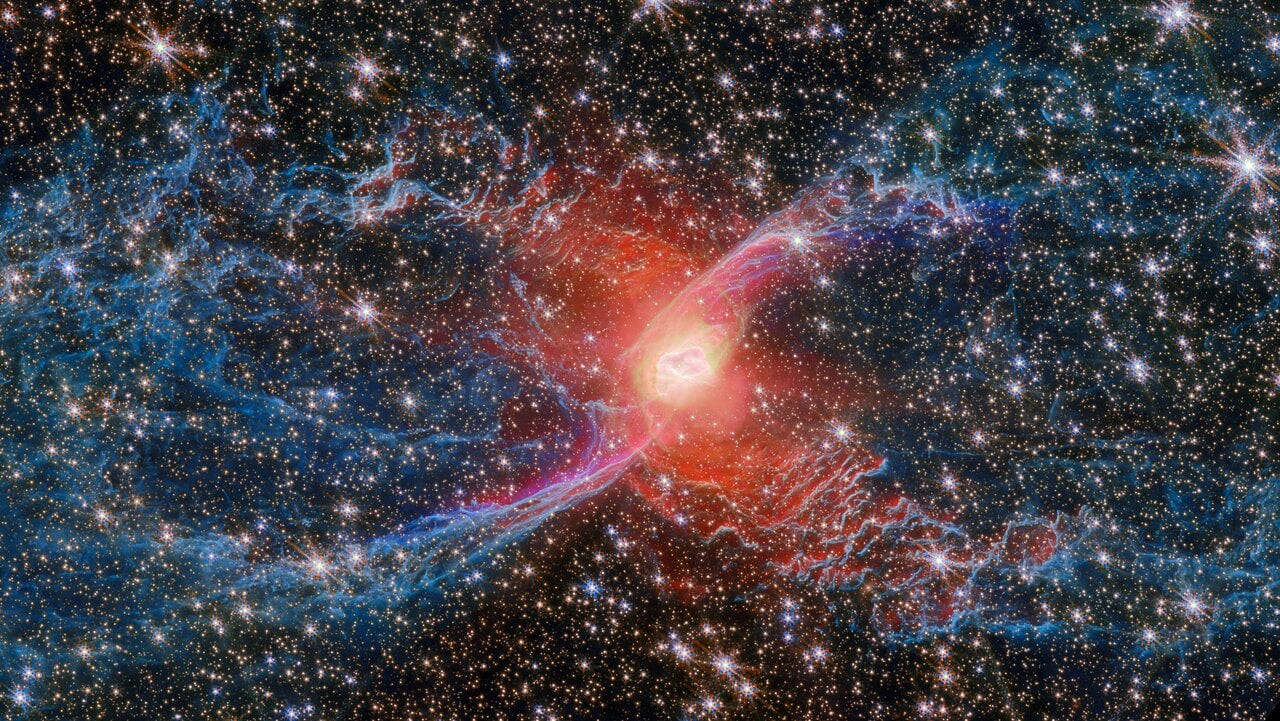New images from the James Webb Space Telescope have revealed NGC 6537, the Red Spider Nebula in unprecedented detail, complete with sprawling legs, a glowing heart, and possibly a hidden companion lurking at its core.
NGC 6537 to use its official name designate it as the 6,537th object in the New General Catalogue and its classed as a planetary nebula, though it has nothing to do with planets. These structures form during a star's dying act, when stars like our Sun exhaust their fuel and swell into red giants. Eventually, the outward pushing thermonuclear force overcomes the force of gravity and they shed their outer layers exposing the core. Ultraviolet radiation from this exposed stellar heart makes the ejected material glow, creating the luminous structures we observe. It's a beautiful finale, but brie, typically only lasting a few tens of thousands of years before fading away.
 This image shows the bipolar planetary nebula, NGC 6537 taken with the New Technology Telescope at ESO’s La Silla Observatory (Credit : ESO)
This image shows the bipolar planetary nebula, NGC 6537 taken with the New Technology Telescope at ESO’s La Silla Observatory (Credit : ESO)
Webb's Near Infrared Camera has done something quite remarkable with the Red Spider though. While Hubble's optical images showed the central star as faint and blue, Webb's infrared vision reveals it glowing red, surrounded by a cloud of hot dust. This dust likely orbits the star in a disc, invisible to our eyes but blazing in infrared wavelengths.
But here's where things get really interesting. Despite only one star being visible, the observations suggest there's a hidden companion that may be sculpting the shape. The nebula's distinctive hourglass shape with its pinched waist and wide outer regions, is a telltale sign of a binary system. Similar structures appear in other planetary nebulae like the Butterfly Nebula, where stellar companions sculpt the ejected material into elaborate forms.
The spider's legs are perhaps the most spectacular revelation. These vast lobes, stretching three light years each and shown in blue in the images, are traced by molecular hydrogen, two hydrogen atoms clinging together. Webb's wide field of view captured their full extent for the first time, revealing them as closed, bubble like structures inflated by thousands of years of outflowing gas.
 This new NASA/ESA/CSA James Webb Space Telescope Picture of the Month features NGC 6537 — the Red Spider Nebula. Using its Near InfraRed Camera (NIRCam), Webb has revealed never before seen details in this picturesque planetary nebula with a rich backdrop of thousands of stars (Credit : NASA/ESA/CSA)
This new NASA/ESA/CSA James Webb Space Telescope Picture of the Month features NGC 6537 — the Red Spider Nebula. Using its Near InfraRed Camera (NIRCam), Webb has revealed never before seen details in this picturesque planetary nebula with a rich backdrop of thousands of stars (Credit : NASA/ESA/CSA)
Meanwhile, something dramatic is still happening at the nebula's heart. An elongated purple 'S' shape marks where fast moving jets of ionised iron burst outward from near the central star, slamming into previously ejected material. These collisions have sculpted the rippling patterns we see today.
These observations are part of a research program led by J. Kastner, investigating how bipolar planetary nebulae acquire their shapes through stellar outflows and jets. Understanding these processes helps us to piece together the final chapters of stellar evolution and offers a glimpse of what awaits our own Sun billions of years from now.

